Demand for thickness planers in Japan is valued at USD 104.8 million in 2025 and is projected to reach USD 143.9 million by 2035, reflecting a CAGR of 3.2%. Demand is supported by steady activity in residential woodworking, home renovation, and small-scale fabrication across hobbyist and professional settings. Thickness planers remain essential for preparing timber with uniform thickness and smooth surface quality, reinforcing their role in furniture making, cabinetry, and precision joinery. Rising interest in compact workshops and do-it-yourself projects continues to strengthen equipment purchases through retail and online channels.
Bench-top units represent the leading segment due to their portability, moderate capacity, and suitability for limited workspaces. These machines provide stable feed control, adjustable depth settings, and sufficient cutting width for most household and small-shop applications. Improvements in cutterhead engineering, chip extraction, and vibration management are enhancing operational reliability and extending service life. Japanese users also show consistent preference for machines that balance precision with reduced noise output.
Demand is concentrated in Kyushu and Okinawa, Kanto, and Kinki, where woodworking activity, renovation spending, and tool distribution networks remain well established. Key suppliers include DeWalt, Makita Corporation, Bosch Power Tools, JET Tools, and Grizzly Industrial. Their focus areas include build quality, repeatable cutting accuracy, and safety-oriented design improvements across bench-top platforms.

Growth momentum analysis shows a steady, moderate trajectory shaped by stable demand from woodworking workshops, joinery facilities, and small-scale manufacturing. Between 2025 and 2029, momentum will remain consistent as renovation activity, furniture production, and hobbyist woodworking sustain baseline procurement. Incremental improvements in planer precision, noise reduction, and dust-management features will support early momentum across professional and residential users.
From 2030 to 2035, growth momentum is expected to moderate slightly as the segment enters a mature phase marked by predictable replacement cycles rather than rapid expansion. Demand will remain anchored in routine workshop operations and incremental upgrades to ensure accuracy and equipment longevity. Advances in motor efficiency, safety systems, and digital depth-control settings will maintain a steady flow of replacements without significantly altering the overall pace. The momentum pattern reflects a mature tools segment characterized by long equipment lifecycles, consistent workshop use, and stable procurement behavior across Japan’s woodworking and light-production environments.
| Metric | Value |
|---|---|
| Japan Thickness Planers Sales Value (2025) | USD 104.8 million |
| Japan Thickness Planers Forecast Value (2035) | USD 143.9 million |
| Japan Thickness Planers Forecast CAGR (2025 to 2035) | 3.2% |
Demand for thickness planers in Japan is rising as furniture manufacturers, interior-woodwork shops and hobbyist woodworkers require precision tools to maintain consistent board thickness and surface quality. The growth in renovation of homes, rise of customised furniture and increased interest in DIY woodworking contribute to demand. Japanese firms invest in sophisticated machinery to meet tight tolerances and aesthetic expectations in domestic and export industries. Technological enhancements such as automated feed systems, digital control of cutting depth and dust-extraction integration make modern planers attractive for professional users.
Enhanced accessibility of compact benchtop models supports hobby workshops and educational institutions. The industry expansion is constrained by high equipment cost, space limitations in many Japanese workshops and ageing wood-processing infrastructure that may delay replacement. Smaller businesses may postpone investment until utilisation justifies machinery upgrades; fluctuations in wood-material availability and maintenance costs also influence purchase timing.
Demand for thickness planers in Japan is shaped by workshop space limitations, equipment precision requirements, and the balance between professional and hobbyist usage. Buyers evaluate stability, portability, cutting accuracy, and compatibility with compact working environments typical of Japanese residential and commercial settings. Industry distribution across product type, power source, and end-use industries reflects both industrial manufacturing needs and the growth of home-based craftsmanship.
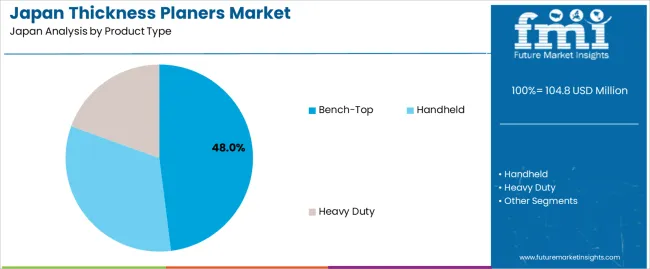
Bench-top thickness planers hold an estimated 48.0% share in Japan, making them the leading category. These models suit Japan’s compact workshop environments and offer stability, predictable cutting depth, and manageable footprint. Their design supports small-scale furniture makers, carpenters, and hobby users who prioritize accuracy without the space requirements of full industrial units. Heavy-duty planers represent 33.0%, used in specialized furniture workshops and industrial processing where higher throughput and wide-board capability are required. Handheld planers hold 19.0%, serving on-site carpentry, renovation work, and lightweight trimming tasks where mobility is essential. Distribution reflects Japan’s emphasis on precision woodworking and space-efficient machinery.
Key drivers and attributes:

Electric thickness planers represent an estimated 57.0% of Japanese demand. Corded electric models provide steady torque, continuous cutting power, and dependable performance suitable for professional woodworkers and small manufacturers. Battery-powered thickness planers hold 29.0%, supported by growing adoption of cordless power tools among contractors and home workshop users. These models appeal to buyers seeking mobility and reduced cable management in confined spaces. Pneumatic thickness planers hold 14.0%, used mainly in industrial workshops equipped with central air systems where continuous airflow supports high-torque operation. Power-source patterns reflect reliability needs, workspace conditions, and structural constraints typical of Japan’s woodworking environment.
Key drivers and attributes:
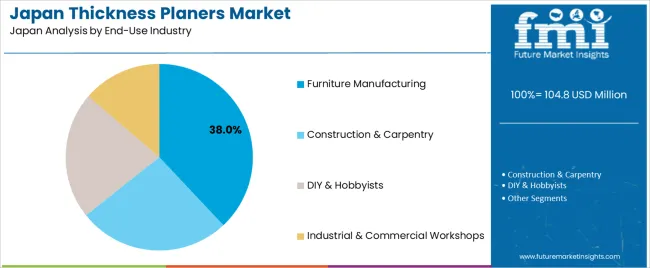
Furniture manufacturing holds an estimated 38.0% share of Japanese demand for thickness planers. This sector depends on precise thickness control for hardwood, engineered wood, and laminated materials used in domestic and commercial furniture production. Construction and carpentry represent 27.0%, reflecting demand for planers in structural trimming, joinery, and interior finishing. DIY and hobbyists account for 23.0%, supported by growth in home workshops and small-scale craftsmanship. Industrial and commercial workshops hold 12.0%, involving batch processing, prototyping, and repair work where players are used alongside other machining equipment. End-use distribution reflects Japan’s emphasis on craftsmanship, wood quality, and precision fabrication.
Key drivers and attributes:
In Japan, demand for thickness planers is supported by growth in custom furniture production, interior building renovation projects, and the small-scale workshop segment. Japanese craft furniture makers and wood artisans emphasise fine surface finish, uniform thickness and natural wood aesthetics, which makes planers essential. The renovation industry in Japan is expanding due to aging housing stock and interest in interior refurbishment, which boosts use of woodworking machinery. Manufacturers are introducing models tailored for compact workshop spaces, reduced noise and improved dust extraction to meet Japanese operational requirements and smaller workshop footprints.
Equipment investment for thickness planers is significant and may face budget constraints in smaller workshops or among solo artisans. Japan’s domestic lumber supply is limited and import costs are high, which can reduce planing volumes and postpone equipment upgrades. The trend toward automation and integrated manufacturing cells in larger furniture and component plants may favour multi-axis machines over dedicated planers, limiting standalone planer sales. Workshop space limitations in urban settings also restrict the size and throughput of planers that can be accommodated.
Manufacturers are offering compact and portable planers specifically designed for small Japanese shops and artisan woodworkers to optimise limited floor space. Growth in reclaimed wood design, up-cycling of vintage materials and bespoke furniture segments supports thinner-board finishing and custom planing workloads. Online machine sales, direct-to-consumer equipment models and subscription-based servicing are improving accessibility for smaller buyers and hobbyists. These trends support continued, albeit moderate, demand for thickness planers in Japan’s woodworking and renovation industries.
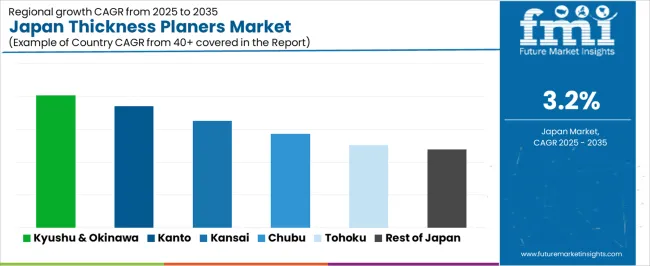
Demand for thickness planers in Japan is increasing through 2035, supported by expanding DIY woodworking activity, steady use of planers in small workshops, and consistent adoption across furniture-repair services and craft-manufacturing facilities. Growth varies across regions based on population density, workshop distribution, and prevalence of carpentry-related trades. Kyushu & Okinawa leads with a 4.0% CAGR, followed by Kanto (3.7%), Kinki (3.3%), Chubu (2.9%), Tohoku (2.5%), and the Rest of Japan (2.4%). Demand is influenced by availability of benchtop and mid-range models, retail access, and workshop activity levels.
| Region | CAGR (2025-2035) |
|---|---|
| Kyushu & Okinawa | 4.0% |
| Kanto | 3.7% |
| Kinki | 3.3% |
| Chubu | 2.9% |
| Tohoku | 2.5% |
| Rest of Japan | 2.4% |
Kyushu & Okinawa grows at 4.0% CAGR, supported by active woodworking culture, strong adoption of compact benchtop planers, and steady demand from small furniture workshops across Fukuoka, Kumamoto, and Kagoshima. DIY users purchase planers through hardware stores and e-commerce platforms to support cabinetry, shelving, and interior-wood projects. Professional woodworkers rely on planers for surface preparation and dimensional accuracy when working with softwood and hardwood. Tourism-driven renovation of small guesthouses and retail interiors also contributes to consistent planer usage. Regional demand remains stable due to balanced adoption across professional and household users.
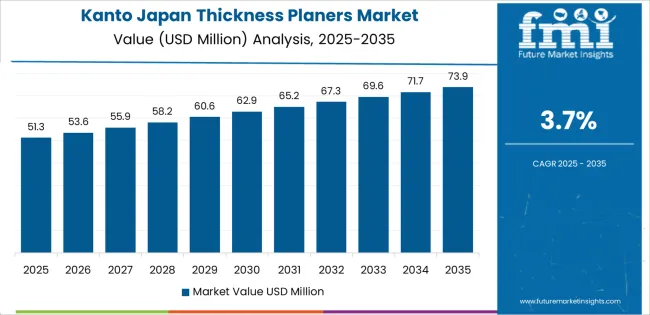
Kanto grows at 3.7% CAGR, driven by dense urban populations, strong hobby woodworking activity, and widespread availability of portable planers across major retailers. Tokyo, Kanagawa, and Saitama maintain high consumption of compact planers suited to limited workshop space, with users relying on them for furniture repair, interior-wood finishing, and small-scale craft production. Craft studios and maker spaces also incorporate planers into equipment inventories, supporting consistent use across varied skill levels. Professional carpenters use larger planers in renovation projects, though benchtop models dominate regional sales.
Kinki grows at 3.3% CAGR, supported by active small-business woodworking operations and consistent renovation activity across Osaka, Kyoto, and Hyogo. Workshops use planers for cabinet construction, surface leveling, and custom furniture production. DIY users purchase compact models for home-improvement projects, supported by strong regional retail networks. Cultural craftsmanship in Kyoto encourages use of planers for traditional woodworking processes requiring smooth, uniform surfaces. Professional carpentry services rely on planers for repeat precision tasks.
Chubu grows at 2.9% CAGR, supported by moderate workshop activity and steady household woodworking participation across Aichi, Shizuoka, and Nagano. Planers are used in cabinetry, furniture repair, and structural-wood preparation in regional renovation projects. Outdoor-oriented hobby communities in mountainous areas contribute to small but steady demand for planers used in DIY cabin repairs and furniture building. Retail availability remains strong, though planer usage is concentrated among hobbyists and small woodworking shops rather than large commercial facilities.
Tohoku grows at 2.5% CAGR, supported by steady woodworking activity in colder regions where indoor craft and furniture projects remain common. Consumers in Miyagi, Iwate, and Fukushima use planers for structural-wood adjustments, cabinet repair, and household DIY tasks. Workshops maintain moderate demand for mid-range planers suited to mixed softwood and hardwood use. Rural community centers and small craft groups also incorporate planers for training and hobby projects. Growth is gradual due to lower population density but stable across core woodworking users.
The Rest of Japan grows at 2.4% CAGR, supported by scattered woodworking activity across rural prefectures and consistent demand for basic benchtop planers used in small shops. Consumers purchase compact units for furniture repair, small-scale carpentry, and DIY fabrication projects. Workshops adopt planers for essential surface-preparation tasks but operate on limited project volumes. Retail networks maintain standard planer inventories, though product turnover remains moderate. Demand is steady but modest due to smaller populations and fewer professional woodworking operations.
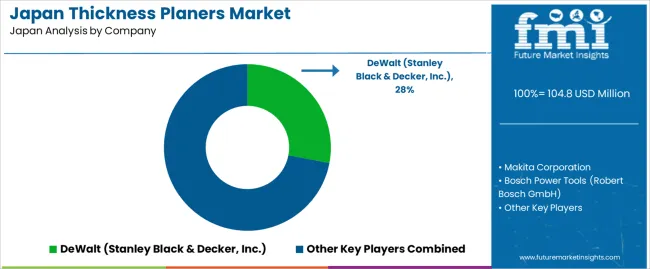
Demand for thickness planers in Japan is shaped by a concentrated group of global and domestic power tool manufacturers supplying professional workshops, small fabrication units, and advanced hobbyist users. DeWalt (Stanley Black & Decker, Inc.) holds the leading position with an estimated 28.0% share, supported by stable motor performance, controlled cutting accuracy, and strong availability through established tool distributors. Its position is reinforced by dependable service networks and consistent build quality suited to frequent use.
Makita Corporation and Bosch Power Tools (Robert Bosch GmbH) follow as major participants, offering planers designed for precise stock removal, vibration reduction, and reliable depth control. Their competitive strengths include robust engineering, compatibility with dust collection systems, and recognition among Japanese users who require consistent finish quality. JET Tools (JPW Industries, Inc.) maintains a solid presence through mid- to heavy-duty machines used in professional woodworking environments that demand uniform thicknessing and stable mechanical performance.
Grizzly Industrial, Inc. contributes additional variety with cost-efficient planers aimed at small workshops and hobbyists, emphasizing wide-cut capacity and straightforward maintenance. Competition across this segment centers on cut precision, motor durability, snipe control, noise management, and operator safety features. Demand is supported by steady activity in custom woodworking, renovation projects, and hobbyist fabrication, where reliable thickness planers remain essential for producing smooth, dimensionally consistent lumber.
| Items | Values |
|---|---|
| Quantitative Units | USD million |
| Product Type | Handheld, Bench-Top, Heavy Duty |
| Power Source | Electric Thickness Planers, Battery-Powered (Cordless) Thickness Planers, Pneumatic Thickness Planers |
| End-Use Industry | Furniture Manufacturing, Construction & Carpentry, DIY & Hobbyists, Industrial & Commercial Workshops |
| Regions Covered | Kyushu & Okinawa, Kanto, Kinki, Chubu, Tohoku, Rest of Japan |
| Key Companies Profiled | DeWalt (Stanley Black & Decker, Inc.), Makita Corporation, Bosch Power Tools (Robert Bosch GmbH), JET Tools (JPW Industries, Inc.), Grizzly Industrial, Inc. |
| Additional Attributes | Dollar sales by product type, power source, and end-use industry categories; regional adoption trends across Kyushu & Okinawa, Kanto, Kinki, Chubu, Tohoku, and Rest of Japan; competitive landscape of woodworking machinery and power tool manufacturers; advancements in motor efficiency, precision control, and dust extraction systems; integration with professional workshops, home improvement activities, and Japanese construction carpentry practices. |
The global demand for thickness planers in japan is estimated to be valued at USD 104.8 million in 2025.
The market size for the demand for thickness planers in japan is projected to reach USD 143.9 million by 2035.
The demand for thickness planers in japan is expected to grow at a 3.2% CAGR between 2025 and 2035.
The key product types in demand for thickness planers in japan are bench-top, handheld and heavy duty.
In terms of power source, electric thickness planers segment to command 57.0% share in the demand for thickness planers in japan in 2025.






Our Research Products

The "Full Research Suite" delivers actionable market intel, deep dives on markets or technologies, so clients act faster, cut risk, and unlock growth.

The Leaderboard benchmarks and ranks top vendors, classifying them as Established Leaders, Leading Challengers, or Disruptors & Challengers.

Locates where complements amplify value and substitutes erode it, forecasting net impact by horizon

We deliver granular, decision-grade intel: market sizing, 5-year forecasts, pricing, adoption, usage, revenue, and operational KPIs—plus competitor tracking, regulation, and value chains—across 60 countries broadly.

Spot the shifts before they hit your P&L. We track inflection points, adoption curves, pricing moves, and ecosystem plays to show where demand is heading, why it is changing, and what to do next across high-growth markets and disruptive tech

Real-time reads of user behavior. We track shifting priorities, perceptions of today’s and next-gen services, and provider experience, then pace how fast tech moves from trial to adoption, blending buyer, consumer, and channel inputs with social signals (#WhySwitch, #UX).

Partner with our analyst team to build a custom report designed around your business priorities. From analysing market trends to assessing competitors or crafting bespoke datasets, we tailor insights to your needs.
Supplier Intelligence
Discovery & Profiling
Capacity & Footprint
Performance & Risk
Compliance & Governance
Commercial Readiness
Who Supplies Whom
Scorecards & Shortlists
Playbooks & Docs
Category Intelligence
Definition & Scope
Demand & Use Cases
Cost Drivers
Market Structure
Supply Chain Map
Trade & Policy
Operating Norms
Deliverables
Buyer Intelligence
Account Basics
Spend & Scope
Procurement Model
Vendor Requirements
Terms & Policies
Entry Strategy
Pain Points & Triggers
Outputs
Pricing Analysis
Benchmarks
Trends
Should-Cost
Indexation
Landed Cost
Commercial Terms
Deliverables
Brand Analysis
Positioning & Value Prop
Share & Presence
Customer Evidence
Go-to-Market
Digital & Reputation
Compliance & Trust
KPIs & Gaps
Outputs
Full Research Suite comprises of:
Market outlook & trends analysis
Interviews & case studies
Strategic recommendations
Vendor profiles & capabilities analysis
5-year forecasts
8 regions and 60+ country-level data splits
Market segment data splits
12 months of continuous data updates
DELIVERED AS:
PDF EXCEL ONLINE
Demand Signal Repository Solutions Market Size and Share Forecast Outlook 2025 to 2035
Demand Side Management Market Size and Share Forecast Outlook 2025 to 2035
Demand Response Market Analysis - Size, Share, and Forecast Outlook 2025 to 2035
North America Shipping Supplies Market Trends – Innovations & Growth 2024-2034
Demand of Kozani Saffron in Greece Analysis - Size, Share & Forecast 2025 to 2035
Demand of No-acid Whey Strained Dairy Processing Concepts in European Union Size and Share Forecast Outlook 2025 to 2035
Demand for Bronte Pistachio in Italy Analysis - Size, Share & Forecast 2025 to 2035
Demand and Trend Analysis of Gaming Monitor in Western Europe Size and Share Forecast Outlook 2025 to 2035
Demand and Trend Analysis of Gaming Monitor in Korea Size and Share Forecast Outlook 2025 to 2035
Demand and Trend Analysis of Gaming Monitor in Japan Size and Share Forecast Outlook 2025 to 2035
Glycine Soja (Soybean) Seed Extract Market Size and Share Forecast Outlook 2025 to 2035
Demand and Trend Analysis of Yeast in Japan - Size, Share, and Forecast Outlook 2025 to 2035
Demand of Pistachio-based desserts & ingredients in France Analysis - Size, Share & Forecast 2025 to 2035
Western Europe Men’s Skincare Market Analysis – Forecast 2023-2033
Demand and Trends Analysis of Stevia in Japan Size and Share Forecast Outlook 2025 to 2035
Japan Women’s Intimate Care Market Trends – Growth & Forecast 2024-2034
Demand and Trend Analysis of Fabric Stain Remover in Korea Size and Share Forecast Outlook 2025 to 2035
Demand and Sales Analysis of Paper Cup in Korea Size and Share Forecast Outlook 2025 to 2035
Demand and Sales Analysis of Paper Cup in Western Europe Size and Share Forecast Outlook 2025 to 2035
Demand of MFGM-enriched Powders & RTDs in European Union Size and Share Forecast Outlook 2025 to 2035

Thank you!
You will receive an email from our Business Development Manager. Please be sure to check your SPAM/JUNK folder too.
Chat With
MaRIA